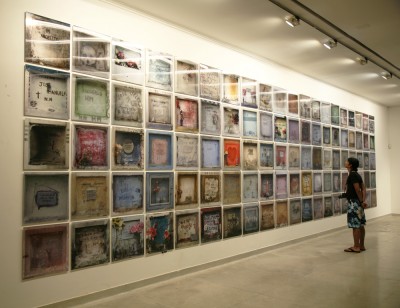Enhancing production
Traditionally, lenticular images have been produced with lithographic printing presses, which are still effective for producing many pieces quickly; but software, resolutions, inks, alignment tools and extruded lenses have all been improved over the course of the evolution of digital inkjet printing.

There is a growing interest in lenticular images for fine-art applications. Photo courtesy Softmotion
As a result, it is easier today to produce more complicated graphics and incorporate animated effects. Special software can convert two-dimensional (2-D) images, especially photography, into a 3-D format by mapping and isolating elements within a given scene. Ultraviolet-curable (UV-curable) inks can be used for direct printing of graphics for outdoor signage and permanent indoor displays.
Nonetheless, each lenticular printing professional has his/her own techniques and tricks and has to become a good technician in the field. The learning curve is steep and there will be a lot of wasted prints at the beginning of anyone’s career. Every application is different, requiring its own ‘mini’ research and development (R&D) process, including mockups and proofs. And if a shop introduces lenticular printing into its existing portfolio of services, but only ends up doing it every other month, it will never get very good at it.
Success in the niche lenticular printing market takes more than a good idea and off-the-shelf interlacing software. It requires careful execution of a sophisticated workflow and communication process, whether the result is a small-format direct mail piece or an 18.3-m (60-ft) wide multi-panel mural.
First, a series of images will need to be created with slightly different perspectives. These are then compressed into a single image composed of many narrow stripes, which are then matched to the lenticules of a specially designed plastic sheet.
With today’s digital inkjet technology, the images can now be printed directly onto lenticular sheets made of polyethylene terephtalate glycol-modified (PETG) co-polyester material. (This material can be manufactured to specifications that meet all requirements for safety and food contact.)
Once the graphics are printed in this way, the sheet will display a sequence of different images when viewed from different angle, creating a single visual to present a product or tell a story. As mentioned, this visual can also become part of a larger piece like a billboard, such that 2-D and 3-D elements are mixed together. Designers will need to be very creative to make those applications happen.
Designing for lenses
The lenses are extruded in various sizes, ranging up to 1.2 x 2.4 m (4 x 8 ft). This upper limit dictates how grand-format applications may be achieved, as any larger size will need to comprise an array of lenticular ‘tiles,’ which is very difficult to co-ordinate while maintaining the integrity of the depth effect and animation concept.
The planning alone for such displays is labour-intensive and expensive, requiring specialized craftsmanship and a lot of patience. So, there tend not to be very many real-world grand-format applications of lenticular technology.
Indeed, given the limitations of lenticular displays, it is fair to say 90 per cent of a print’s success is determined at the design stage. The art, after all, must be designed to be compatible with the lenses, with appropriate contrast levels, colour matching and background elements.
If the client demands an image that is not compatible, it is better to walk away from the job before it becomes a visual disaster. That said, the client may simply need to allow a few adjustments to make the artwork effective.
Another issue is lens quality. Even after they are specially extruded, lenses are not perfect. They can create visual distortions if their lenticules are not perfectly straight and parallel. This is especially true with large-format lenses, which fewer extruders can achieve and where distortions will be all the more obvious to the viewer.







